Note: You need the
Symbol font (68 kB)
in order to display various symbols correctly, such as
![]() (otherwise they appear as
p, r, q and f ).
(otherwise they appear as
p, r, q and f ).
Note: You need the
Symbol font (68 kB)
in order to display various symbols correctly, such as
![]() (otherwise they appear as
p, r, q and f ).
(otherwise they appear as
p, r, q and f ).
The function f (x) is defined on the interval [0, 1] by

Sketch the even periodic extension of this function.
![Even extension of f(x) to [-1, 1]](f09/q1graph1.gif)
Even extension of f (x)
to [–1, 1]
Even periodic extension of f (x)
to the entire real number line
[not required by this question]:

[This latter sketch is of the function to which the Fourier cosine series converges.]
Find the Fourier cosine series for f (x) .
L = 1
Even periodic extension
![]()
![a_0 = [integral]](f09/q1a01.gif)
![]()
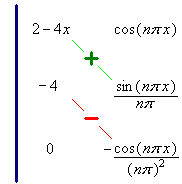
![a_n = [integral]](f09/q1an0.gif)
![a_n = [integral]](f09/q1an1.gif)
![a_n = [integral]](f09/q1an2.gif)

The Fourier series for any even function is

Therefore the Fourier cosine series is

The first few terms of this series are

The graphs of the partial sum of the Fourier series as far as the n = 3 term (in blue) and the original function (in red) are shown here:
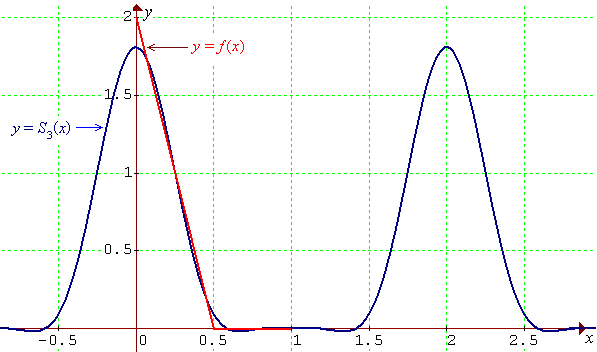
The Cartesian equation of a surface S
is
![]() .
.
Classify this quadric surface [an answer of less than five words is sufficient].
| hyperboloid of one sheet |
|---|
Find the equation of the tangent plane to
S at the point
![]()
![]()
which is a normal vector to the surface at the point
(1, 2, –2).
![]()
Therefore the equation of the tangent plane is
![]()
![]()
Hence write down the equations of the normal line to
S at the point
The direction vector of the normal line is the same
as the normal vector to the tangent plane.
The normal line certainly passes through the given
point of tangency
The equations of the normal line, in Cartesian symmetric
form, follow immediately:
![]()
A vector field at all points (x, y, z)
in ![]() is
is
![]()
Express this vector field in the cylindrical polar coordinate system.
Convert the Cartesian components into cylindrical
polar form:
![]()
Using the coordinate conversion matrix,
![[matrix multiplication]](f09/q3a2.gif)

![]()
Using the Cartesian coordinate system, find curl F .
![curl F = [determinant]](f09/q3b1.gif)
![]()
Using the cylindrical polar coordinate system, confirm your value for curl F .
![curl F = [determinant]](f09/q3c1.gif)
![]()
A vector field is defined on the xy plane by
![]()
A simple closed path C is defined by
a triangle whose vertices are at the points
(0, 0), (1, 0) and (0, 1).
Can Green’s theorem be used to evaluate the work done by F in one circuit of C ? Why or why not?
![[plot of triangle enclosed by path C]](f09/q4path.gif) The only singularities of F
occur along the line
The only singularities of F
occur along the line
which is entirely outside C .
F is differentiable everywhere on and
inside C . Therefore
| YES |
|---|
Green’s theorem can be used to evaluate the work done by F in one circuit of C .
Find the exact value of the work done by F in one circuit of C .
Using Green’s theorem,


![[triangular region of integration D]](f09/q4limits.gif) But the region D is not a
rectangle.
But the region D is not a
rectangle.
If the integration with respect to y
is performed first,
then the limits on the inner integral run
from

![[evaluating inner integral]](f09/q4b4.gif)
![[evaluating outer integral]](f09/q4b5.gif)
If the integration with respect to x
is performed first, then the limits on the inner integral
run from

![[evaluating inner integral]](f09/q4b7.gif)
![[evaluating outer integral]](f09/q4b8.gif)
The work done may also be calculated using a direct evaluation of the line integral, but this involves three separate integrations and considerably more effort. By any one of these three methods, the work done is
![]()
A parabolic cylindrical coordinate system
(u, v, w) is related to the
Cartesian coordinate system
![]()
![]()
![]()
![]()
For any orthonormal coordinate system, the expression
for the divergence is

Using the scale factors from part (a) and the components
of F :


![]()

![]()
For any orthonormal coordinate system, the expression
for the curl is
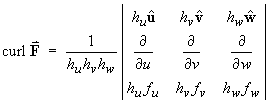
Using the scale factors from part (a) and the components
of F :
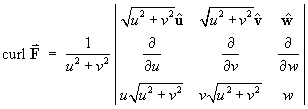

![]()

![]()
[with the possible exception of the line u = v = 0 , which is the z-axis.]
From part (c) above,
![]() everywhere
except possibly on the z-axis. Therefore
everywhere
except possibly on the z-axis. Therefore
| YES |
|---|
on a simply-connected domain that excludes the z-axis, a potential function does exist for F.
A thin shell S is in the shape of
part of a cylinder, radius 2 m, centred on the
z axis, from ![]() of the shell at any point
of the shell at any point
![]() kg m–2.
kg m–2.
What is the range of possible values of the constant a , if the mass of every part of the shell is non-negative?
![[diagram of cylinder]](f09/q6cylinder.gif) Non-negative mass requires non-negative density
Non-negative mass requires non-negative density
But, everywhere on the cylinder,
| x | < 2
![]()
The two extreme values of density on the cylinder occur
at x = ±2
![]()
![]()
Therefore the bounds on the parameter a
are
![]()
Find the mass m of the shell.
The obvious parametric grid to use on this surface
is the (![]() , z) pair from the
cylindrical polar coordinate system.
, z) pair from the
cylindrical polar coordinate system.
The radius of the cylinder is 2 units.
Therefore ![]() = 2 everywhere on
the shell.
= 2 everywhere on
the shell.
The element of area is therefore
![]()

But everywhere on the cylindrical surface,
x = 2 cos ![]() :
:
![]()
![]()
![]()
Find the location
![]() of the centre of mass of the shell.
of the centre of mass of the shell.
The shell has obvious geometric symmetry about the
z axis, half way between the bottom and top of
the cylinder.
The surface density depends on x
only, so that the mass distribution is also symmetric
about
However, the mass distribution is not symmetric
about
Evaluating the x component only of the moment
vector:

![]()
![]()
![]()
![]()
Therefore the location of the centre of mass is
![]()
Water is flowing along a horizontal cylindrical pipe that has a circular cross section of constant radius a (metre). The line of symmetry of the cylindrical pipe is aligned along the y-axis. The velocity of the water at all points in the pipe is
![]()
where vo is the
maximum speed (in ms–1) of the water in
the pipe.
Find the rate Q
(in m3s–1) at which water is
flowing across any circular cross section of the pipe.
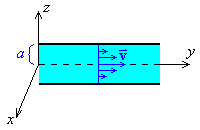 All circular cross sections of the pipe are parallel to the
xz plane.
All circular cross sections of the pipe are parallel to the
xz plane.
All such cross sections therefore share the same constant
normal vector N = j.
In any cross section y = constant , use plane
polar coordinates:
![]()

Therefore the total flux of water across any circular cross
section of the pipe is

![]()
![[Evaluating the Integral]](f09/q7flux3.gif)
![[Evaluating the Integral]](f09/q7flux4.gif)
![]()
One can check that the answer is dimensionally consistent:
The dimensions of Q are (m)2
× (m s–1) =
(m3s–1) which is, indeed,
the dimensions of volume per unit time.
For the partial differential equation
![]()
![]()
Therefore the PDE is everywhere
| hyperbolic |
|---|
![]()
The complementary function is
![]()
The right side is a constant (zero-order polynomial) and
the left side involves only second partial derivatives.
Therefore try a second order polynomial as the particular
solution:
![]()
![]()
Substituting these partial derivatives into the PDE:
![]()
This is an underdetermined system (only one equation for three
unknowns), leaving a free choice for two of the three
coefficients.
Choosing b = c = 0 forces
a = 1 so that
The general solution is the sum of the complementary
function and the particular solution:
![]()
Note that other forms of the general solution are
valid, such as
![]()
Solutions for alternative choices of a, b, c are available at this link.

Starting with the form of the general solution found
in part (b) above,
![]()
![]()
![]()
![]()
![]()
![]()
Note that we can ignore the arbitrary constant of integration
here.
It will cancel out when the complete solution is assembled.
![]()
The complete solution is therefore
![]()
![]()
It is straightforward to check that this function satisfies both additional conditions and the partial differential equation.
There are many alternative routes to this solution, but the route shown here is the fastest.
![]() [Back to the Index of Solutions]
[Back to the Index of Solutions]
![]() [Return to your previous page]
[Return to your previous page]
Created 2009 05 08 and most recently modified 2009 06 04 by
Dr. G.H. George